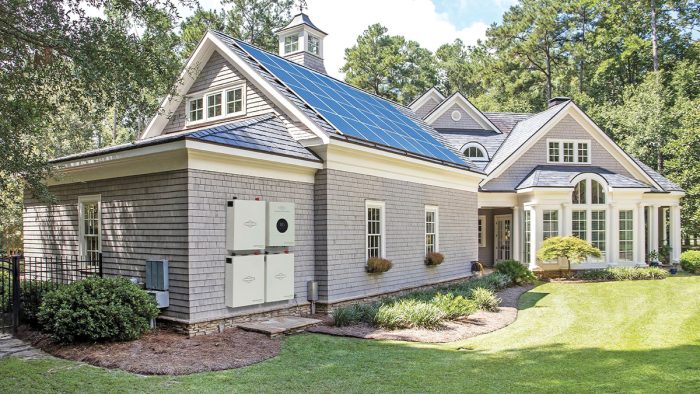High-Tech Batteries and More
Discover the latest technology for storing energy at home.

Power outages are a fact of life in the uber-connected 21st century. When Tesla introduced the first Powerwall in 2015, it was a true innovation: Not only could this sleekly minimalist device charge your car but it could also store the excess energy from solar panels for later use—a real advantage during a blackout.
Sure, you can still buy a conventional generator that runs on natural gas or propane. But when linked to a solar array, a properly configured battery system can power and store enough energy to maintain the electrical needs of a large house. On some days, it may generate enough excess juice to back-feed the electrical grid.
Modern Power Solutions
Offered by manufacturers including Briggs & Stratton and Generac, new backup systems are based on lithium iron phosphate cells, or LFPs. While LFPs have been around since the 1990s, they’re too heavy to put into electric vehicles. Unlike the batteries that power EVs, however, LFPs are free of cobalt, a toxic element that may cause batteries to spontaneously ignite.
Instant PowerIf you’re looking for a basic backup system that stores energy for use during an outage, consider a battery-powered kit. Among the most powerful is Ecoflow’s Delta Pro kit, part of a line of dozens of portable battery options.  The easy-to-maneuver, battery-powered unit connects to an electrical breaker panel using a dedicated power inlet box or transfer switch installed by an electrician. Charge it up and it’s ready to use with the flip of a switch. It can also run off solar panels, even portable ones. Best of all, at $4,000 to $6,000, it’s less than half the price of a fully installed backup system. |
They’re also cheaper and they last longer. An LFP that’s charged and discharged daily will likely lose only 20 percent of its original capacity over a 10-year period. EV car batteries have a much shorter lifespan. For the first time, in fact, Tesla’s new Powerwall3 will be based on LFP technology.
Another benefit of LFPs: They can be charged to 100 percent of capacity. (EV owners are warned not to fully charge their batteries as it speeds battery aging.) LFP systems make the most sense when powered by solar but are not necessarily solar-dependent.
Take a Closer Look
Briggs & Stratton’s vertically integrated energy-storage system, SimpliPHI, runs on AC or DC power and can be paired with solar, generator, or electrical-grid power. If the power goes out, “you won’t even see the lights flicker,” says Daniel Moyer, a company trainer.
A basic closed-loop SimpliPHI system consists of an LFP-ready inverter, one or more battery packs, and software to monitor it via a smart phone. The inverter converts the battery’s direct current to the alternating current your appliances use; the battery packs store and discharge power. Installers like the app because they can monitor them for error codes and even reconfigure them remotely.
In addition, the software makes it possible to download energy off-peak, when rates are lower. That not only benefits homeowners but also reduces demand on strained power grids. You can start small, adding inverters and batteries to increase power or get you through longer outages.
 |
 |
More Options to Consider
Generac’s PWRcell system shares some properties with SimpliPHI but is designed to work with newly installed solar systems. (Tesla’s Powerwall works with existing and new.) During the day, the house runs on solar power as solar panels recharge the battery.
At night, the house runs on stored energy. When solar power is not sufficient, Generac’s DC-coupled generator quickly recharges the cell battery, making it possible to power a home long-term during an outage.
A basic SimpliPHI LFP system with an inverter and two battery packs costs about $12,000. If you want whole-house energy or are off the grid, consider a battery “cabinet” of six or more units, at $15,000 and up, exclusive of solar panels. Both types are eligible for the 30 percent energy tax credits enacted in 2022. Talk to your electrician or solar installer about how much capacity you need.
Resources
|
— Photos courtesy of the manufacturer.
RELATED STORIES


























